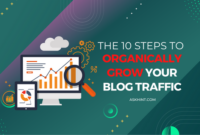Search engine optimization (SEO) is a crucial part of running an online business. From improving your rank on search engine results pages to ensuring your content reaches the right audiences, SEO can make or break your website’s performance. However, figuring out how to optimize for different search engines can be a challenging task. Luckily, there are some simple ways to improve your on-page SEO without spending too much time or effort. In this blog post, we’ll cover 10 easy and effective ways to improve your on-page SEO quickly and easily. From keyword research to page titles and meta descriptions, read on to learn more about the small changes you can make today for big returns in the future!
1. Use keyword-rich titles
It’s no secret that keywords are important for on page SEO. In fact, using relevant keywords is one of the most important factors in ranking well on search engines. However, simply using the right keywords is not enough. You also need to use them in the right way.
One of the best ways to do this is to use keyword-rich titles. A keyword-rich title is a title that includes one or more relevant keywords. For example, if you were writing an article about how to improve your on page SEO, you could include the keyword “SEO” in the title.
Not only will using keyword-rich titles help you rank better on search engines, but it will also help readers find your content more easily. After all, if they’re searching for information on “SEO,” they’re more likely to click on an article with that keyword in the title than one without it.
So, if you want to improve your on page SEO, start by using keyword-rich titles for your articles and blog posts. It’s a simple change that can make a big difference in your traffic and search engine rankings.
2. Optimize your meta tags
If you want your website to rank higher in search engine results, you need to make sure your on-page SEO is up to par. One of the most important aspects of on-page SEO is optimizing your meta tags.
Your title tag and meta description are what show up in the search results, so it’s important to make them accurate and keyword-rich. Including keywords that are relevant to your business and target audience will help you attract more clicks from potential customers.
Make sure your title tags are no more than 60 characters long, and your meta descriptions are no more than 160 characters. If you include too much information, search engines will truncate it in the results.
Including a call-to-action (CTA) in your title tag or meta description can also encourage people to click through to your website. For example, if you’re a web design company, you could include a CTA like “Get a free quote” or ” designing websites.”
By optimizing your meta tags, you can improve your click-through rate and attract more visitors to your website.
3. Use keyword-rich descriptions
It’s no secret that keyword-rich content is important for on page SEO. But what exactly does that mean?
Basically, it means including relevant keywords throughout your website’s content – in the titles, in the body text, in the meta tags, etc. – so that search engines can easily identify what your site is about and rank it accordingly.
There are a few things to keep in mind when creating keyword-rich content:
1. Use relevant keywords. Obviously, you want to include keywords that are relevant to your business and products/services. But you also want to make sure they’re popular enough that people are actually searching for them. Use tools like Google AdWords Keyword Planner to research popular keywords in your industry.
2. Don’t stuff keywords. Stuffing keywords (meaning cramming them into your content unnaturally) will not only turn off readers but also get you penalized by search engines. Use keywords sparingly and only where they make sense.
3. Vary your keyword usage. Using the same keyword over and over again (even if you’re using it correctly) will make your content sound repetitive and robot-like. Mix things up by using related keywords, synonyms, and long-tail keywords (which are simply different variations of a main keyword).
Following these tips will help you create keyword-rich content that’s both search engine and reader-friendly.
4. Use keyword-rich headings
When it comes to on page SEO, one of the most important things you can do is to use keyword-rich headings. This will help search engines understand what your page is about and index it accordingly.
There are a few things to keep in mind when creating keyword-rich headings:
Choose a main keyword for each heading. This should be a word or phrase that accurately describes the content of the section.
Use secondary keywords throughout the heading to further describe the content. However, don’t stuff keywords into your headings – this will only hurt your SEO.
Make sure your headings are formatted correctly. Heading tags (H1, H2, H3, etc.) tell search engines how important each heading is. So, use them wisely!
By following these tips, you can create keyword-rich headings that will improve your on page SEO and help search engines find and index your content more effectively.
5. Use keyword-rich images
If you want your on page SEO to be super effective, start by using keyword-rich images. This means including keywords in the file names and alt text for your images. By doing this, you’ll help search engines understand what your images are about and index them accordingly.
In addition to using keyword-rich images, also make sure that your images are relevant to the content on the page. Search engines take into account the context of an image when determining its rankings, so if your image is relevant to the topic of the page, it will likely rank higher.
Finally, don’t forget to optimize your images for speed. Slow-loading images can negatively impact your SEO, so make sure that your images are as small as possible without sacrificing quality. There are a number of ways to do this, including using an image compression tool or setting the correct file type (JPEG for photos and PNG for graphics).
6. Optimize your website for mobile
Improving your on page SEO doesn’t have to be complicated or time-consuming. One simple way to make your site more search engine friendly is to optimize it for mobile devices.
More and more people are using their smartphones and tablets to access the internet, so it’s important that your website is designed for these smaller screens. Mobile-friendly websites load faster and are easier to navigate, which can improve your chances of ranking higher in search results.
There are a few different ways to make your site mobile-friendly. You can create a separate mobile version of your site, or use responsive design to automatically adjust the layout of your pages for different screen sizes. You can also use Google’s Mobile Friendly Test tool to see how well your site performs on mobile devices.
Making your website mobile-friendly is a quick and easy way to improve your on page SEO. By optimizing for smaller screens, you’ll ensure that your site can be easily found and accessed by potential customers – no matter what device they’re using.
7. Optimize your website for speed
Slow loading websites are a major turnoff for visitors. Not only does it frustrate users, but it can also hurt your business by driving away potential customers. Fortunately, there are a number of simple ways to improve your website’s speed and performance.
First, take a look at your website’s code and make sure it is clean and well-organized. This will help your pages load faster and reduce the chance of errors.
Next, optimize your images for the web. This means saving them in the correct file format and sizing them so that they load quickly.
Finally, make sure you are using a good web hosting provider that can give you fast page loading times. A good host will have a positive impact on your website’s speed and performance.
8. Use social media to promote your website
There are a number of ways to use social media to promote your website. Perhaps the most obvious is to share links to your website on your social media profiles. This can help to drive traffic to your website and also help to improve your search engine ranking. Another way to use social media to promote your website is to share content from your website on social media. This could be in the form of blog posts, infographics, images, or even just snippets of text. If people like what they see, they are likely to click through to your website. Finally, you can use social media advertising to target people who are interested in the products or services that you offer on your website. By targeting your ads specifically at these people, you can increase the chances of them clicking through to your site.
Conclusion
On-page SEO is a powerful tool that can help you get your website noticed and ranked in search engine results pages. With the right know-how, it’s easier than ever to optimize your website for maximum visibility. We hope that our list of 10 super easy ways to improve on page SEO has been helpful in helping you get started. If followed correctly, these tips should help you make sure that your website is seen by more people and rank higher in SERPs. Good luck!



